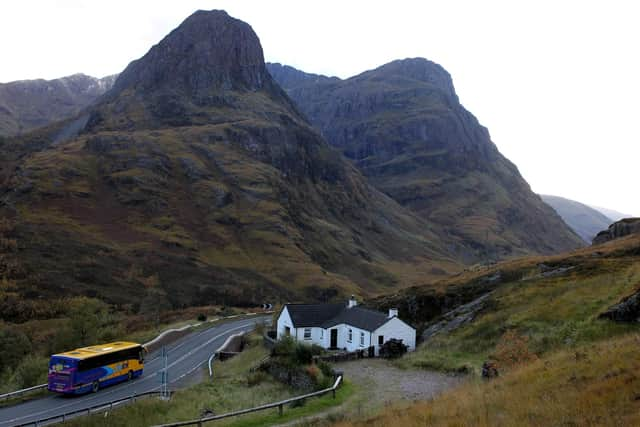Heritage chiefs object to designs of new Glen Coe house on site of Jimmy Savile's old cottage
Heritage chiefs have rejected fresh designs for a new contemporary family home at the site of Jimmy Savile’s former cottage in Glen Coe given its impact on one of Scotland’s “most popular natural wonders”.
National Trust for Scotland has made an official objection to the proposals lodged by Fife-based retail entrepreneur Harris Aslam, who has returned with a new design for Allt-Na-Reigh after planners did not support his original proposals.


Advertisement
Hide AdAdvertisement
Hide AdAllt-Na-Reigh was originally the home of famed mountaineer Hamish MacInnes, who designed climbing equipment in the outbuildings of the home, with the cottage latterly owned by Jimmy Savile. It has been repeatedly vandalised since his life as a sex abuser and paedophile was exposed.
Mr Aslam wants to demolish the cottage and build a new three-bedroom house, which would be around double the size of the cottage, with the new property contemporary in design with a few nods to a more traditional style. The outbuildings are to be named “Hamish House” in honour of the late mountaineer
Clea Warner, NTS regional director for Highlands and Islands, said the conservation charity, which owns 14,000 acres of Glencoe, objected to the proposals.
Ms Warner added: “The proposed new building’s substantially enlarged scale and contemporary design does not reflect Glen Coe’s long-established, distinct built heritage and would insensitively dominate the landscape in a highly visible location at the heart of the “Pass” of Glen Coe (a highlight of the Ben Nevis and Glen Coe National Scenic Area).
"We do not think that there is a sufficient justification for this unprecedented innovation or that reasonable alternatives do not exist. It is the views afforded by a drive through Glen Coe that make this landscape one of Scotland’s most popular natural wonders.”
Glen Coe was designated a Nature Reserve in 2018 in recognition of its beauty and natural heritage with Alt-Na-Reigh surrounded by NTS land, which is visited by hundreds of thousands of people a year.
Ms Warner added: “We represent the views of 330,000 members who expect us to speak up and we have received requests to raise our concerns on this particular planning application.”
Ms Warner said she disagreed with the applicant’s statement there was no “established pattern of development in the area” with properties through the glen all white-wash stone cottages with slate roofs.
Advertisement
Hide AdAdvertisement
Hide AdDevelopers described the new designs as a “a subtle homage” to the former building and “intrinsically tied to the traditional vernacular of the area” but NTS has disagreed given the size and scale of the building and the use of contemporary building materials such as blackened wood, zinc roofs and large sheet-glass picture windows.
Ms Warner added: “We make no comment on whether we like or admire the new building design as we don’t think this is relevant. We simply state that it does not blend in with the Glen’s existing built heritage, visual identity and spirit of place.
"Clearly the current vandalised state of Allt-Na-Reigh, which has been exacerbated by the absence of a permanent resident for many years now, needs to be addressed. However, this site’s natural and cultural heritage goes back far beyond this recent unfortunate chapter and should not be set aside in the search for a solution.”